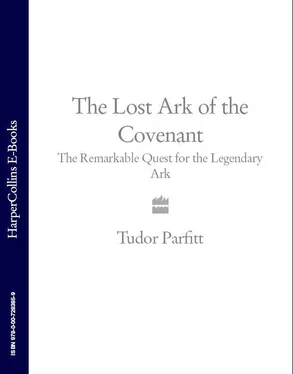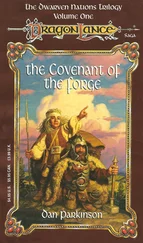Again, he read from the book. ‘“In the desolation of the Valley of Achur, in the opening under the ascent, which is a mountain facing eastward, covered by forty placed boulders, here is a tabernacle and all the golden fixtures.” This may well refer to the Ark,’ he added, rubbing his chin with unnecessary vigour.
I had a sudden flashback to the night I spent walking over to the cave of Dumghe with my police bodyguard Tagaruze: Dumghe was a mountain facing eastward and it was indeed covered with great round boulders. I had been told that the ngoma lungundu was hidden beneath it. Was it possible that there was a connection?
‘The valley of Achur?’ I interrupted. ‘Does that resonate with you at all? Does Achur mean anything? Do you have any idea where it is?’
‘No, unfortunately not,’ he replied. ‘The anonymous author of the Copper Scroll as you may realize gave no map references. It has been posited that it refers to an area around Mount Nebo in Jordan. This is what the apocryphal book of Maccabees says. He took a book down from the shelves and read aloud.
‘The prophet [ Jeremiah], being warned of God, commanded the tabernacle and the Ark to go with him, as he went forth into the mountain, where Moses climbed up [Mount Nebo], and saw the heritage of God.
And when Jeremy came thither, he found a hollow cave, wherein he laid the tabernacle, and the Ark, and the altar of incense, and so stopped the door. And some of those that followed him came to mark the way, but they could not find it. Which when Jeremy perceived, he blamed them, saying, as for that place, it shall be unknown until the time that God gather His people again together, and receive them unto mercy.’
‘Another thing,’ he said, ‘is that there are a number of indications that there may have been two or more Arks. The first Ark was built to house the two tablets of the law which had been engraved by “the finger of God.” When the people of Israel started worshipping the golden calf rather than the One God Moses broke the tablets and was commanded to create a new set himself with the identical text. Jewish tradition suggests that there was one Ark intended to house the broken tablets of the Law and another for the tablets carved by Moses.’
Rabin smiled at me in a boyish way, and for a second I could see the Berlin schoolboy of decades before.
‘The sages of blessed memory drew a moral from the idea that even the old broken tablets had a place of honour in the Ark - the moral was that even an old scholar like me who has forgotten most of his learning still deserves respect. And he still deserves his rest .’
The old man, who suddenly looked very frail, ushered me to the door and explained that it was time for his afternoon sleep. He faltered as we reached the entrance to his study and his face seemed to go blank. Gathering himself he murmured gently, ‘My mother made me learn a long poem in English when I was a little boy. Let’s see if I can remember some of it:
‘Maybe ’tis true that in a far-off land
The Ark of God in exile dwelleth still,
It resteth ever with the pure of hand,
Who do his will.’
He recited it in the fluting voice of a prepubescent boy. Smiling, he let me out.
Again the Jerusalem sirens were letting the world know that all was not well in the City of Peace. Wondering if the ‘pure of hand’ were still guarding the Ark in some remote corner of the world I walked back to the Old City with a good deal on my mind.
A couple of days later I arranged to meet Reuven at Finks’ Bar, on the corner of King George and Histadrut Street in western Jerusalem. There were troops everywhere and the city was tense.
True to his word, Rabin had sent me a bibliography with several dozen entries through the mail. He also sent me a brief and courteous letter apologizing for breaking off before we had really finished our conversation. He wanted to define his thoughts more clearly.
When I was a boy in Germany, [he wrote] all those years ago, during the Weimar Republic, who would have imagined that the Dead Sea Scrolls would be discovered? The scrolls, written on parchment, are much more fragile, after all, than gold or silver objects or even the Ark made of shittim wood. And if they were rediscovered in the caves of Qumran after two thousand years, why not the Ark and the Temple treasure!
Reuven read the letter, nodding in agreement. I told him that Rabin had said that the Copper Scroll seemed to offer the best way forward if it was ever possible to decode the clues. As I ordered a whisky for both of us he skimmed through the bibliography and brought me up to date on recent searches for the Ark. He had been making enquiries for the previous few weeks.
As Rabin had suggested, a lot of people were after it.
There was a young American eccentric who hung around the Petra Hotel just inside the Jaffa Gate. He drank a lot of vodka and had more girlfriends than he could handle, but he had a degree in Semitic languages from Stanford and a good mind. He had made friends with an Arab family who owned a house not far from the Temple Mount and had allegedly been burrowing enthusiastically in their courtyard. Reuven said there were others like him and distractedly gave me an account of recent claims.
He spoke at length about three Americans who had been hot on the trail of the Ark. There was the Ron Wyatt from Tennessee that Rabin had mentioned who had actually claimed to have found the Ark in a cave near Jerusalem. He told me of a research physicist in the Radio Physics Laboratory of SRI International in Menlo Park, California - who had flown over the Temple Mount to X-ray its foundations with caesium-beam magnetometers but had failed to locate the Ark. And there was a To m Crotser, who had announced in 1981 that he had unearthed the Ark near Mount Nebo in Jordan. Photographs had been taken but only one had been released to the public and that appeared to show a recentlooking brass chest with a decidedly modern-looking nail sticking out of it.
Finks’ was full of writers, poets, and some quite well-known politicians. As usual it was dimly lit. All of the seven tables were taken - people were eating goulash soup or tafelspitz with khren - horseradish and beetroot sauce - Austro-Hungarian house specialities pandering to the diaspora traditions and nostalgia for elsewhere which permeates every aspect of Israeli life.
A dark-suited politician came over to our table and in a low voice told us that there had been some alarming discussions of opening up an entrance under the Temple Mount. The Shin Bet - Israel’s internal security service - was studying likely Muslim reactions. The politician explained: ‘There were some unauthorized excavations done by Ateret Cohanim a year or so back looking for the Ark which caused a good deal of resentment on the part of the Muslim population. In October 1991, a group called the Temple Mount Faithful marched on the compound carrying provocative banners. It was rumoured that they were planning to lay the foundation stones for a new Temple. As you know, 22 Palestinians were killed in the ensuing riots. If any major excavation was done down there now, blood would be spilt throughout the Muslim world from Casablanca to Karachi! And Jews would not be spared.’
A few minutes later, my oldest Jerusalem friend, Shula Eisner, who worked with the Mayor of Jerusalem, Teddy Kollek, sashayed into the bar with the mayor and a group of overdressed American guests of the city. Shula came over for a moment. I had told her about Reuven and his interest in the Ark, and I took this opportunity to introduce them. As she was leaving, I asked her if the Municipality had been involved in closing down the Temple Mount excavations. And whether they were involved in discussions to open them up again.
Читать дальше












